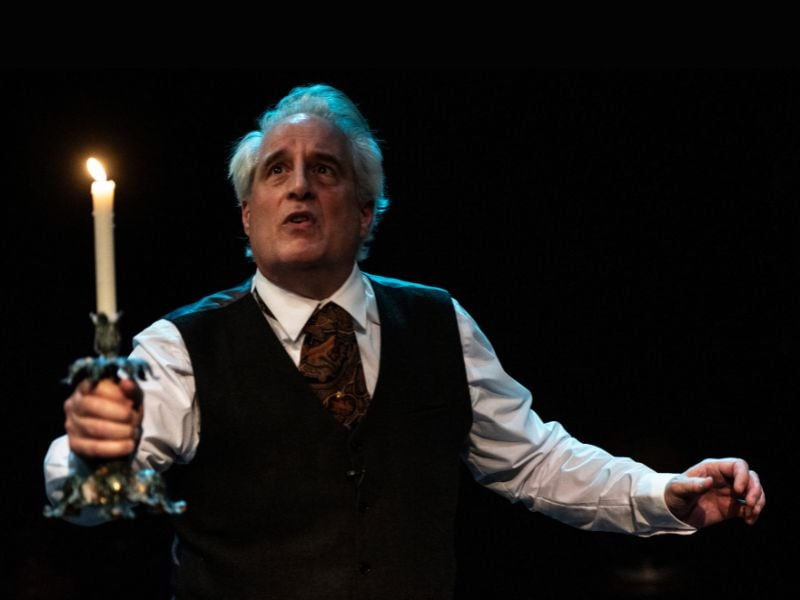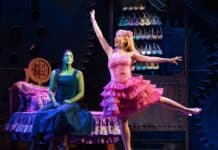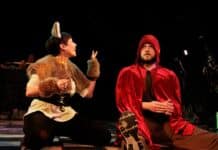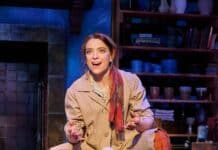Charles Dickens’ classic novella A Christmas Carol has been continuously in print since it was first published in 1843 and has become an inseparable part of Christmas traditions throughout the English-speaking world. There have been innumerable adaptations — 23 live-action films (one starring Muppets), 11 animated films, 32 TV productions, plus countless theatrical versions, musicals, operas, ballets, and even video games.
But these were far from the first translations of the tale from page to stage. Dickens himself originally became an entertainment superstar on a series of famous tours on both sides of the Atlantic, where he would recite excerpts from his stories aloud to rapturous audiences, acting out all the characters. The adaptor of this version for Olney Theatre Center, Paul Morella, finds it ironic that what makes this iteration distinctive is its return to its original format and its fidelity to Dickens’ words.

Truly, here the language is the star. Phrases such as “God bless us, every one!” and “Marley was dead, to begin with” and “Bah, humbug!” have entered our Christmas lexicon. But the entire work is full of prose richer than sugar plums, and it seems stingy, almost Scrooge-like, of playwrights to rob audiences of gems like “every idiot who goes about with ‘Merry Christmas’ on his lips should be boiled with his own pudding, and buried with a stake of holly through his heart!” The limiting factor, of course, is time. The entire book takes about three and a half hours to read aloud, and even audiences overflowing with seasonal spirit (or spirits, in every sense?) might balk at sitting through the whole thing.
But this adaptation takes great pride in fidelity to the text. Out of Dickens’ original 30,762 words, we are given 12,984, or 42%, and according to the program notes, only 65 are not from the original. Most of what is cut is embellishment and scene-setting (Dickens was paid by the word for his later novels, and he could go on a bit…), but anyone who reads the novel faithfully every year might hunger for such luscious descriptions as the half-closed shops on Christmas morning, still brimming with tasty delights, or the weathered lighthouse keepers who “wished each other Merry Christmas in their can of grog; and … struck up a sturdy song that was like a gale in itself.” Still, this adaptation includes everything necessary to move the story along with ample respect for Dickens’ masterpiece while taking mercy on modern audiences’ attention spans.
Of course, the presentation at Olney’s intimate Mulitz-Gudelsky Theatre Lab has access to technical resources that Dickens could only have dreamed of, and it makes excellent use of them.
The set (which is not credited to a designer, so perhaps was conceived by the re-mounting director, Hallie Gordon) is comprised of a profusion of Victorian paraphernalia — books, antimacassars, clocks, lamps, coal scuttles, brass letter holders, footstools, more books, etc., some of which are used as props. Above hangs an angled skylight with a few broken panes, as if in a garret, and three ornate frames that throughout the show change contents to present the different scenes. These images, designed by Patrick W. Lord, are excellent — extremely subtle, looking more like long-faded paper than projections. But in some cases, such as with the lamenting spirits in the air, the twinkling holly, or snowfall, they move, adding just that touch of magic to the scene.
Kudos to real candles on a stage (so many theaters insist on only artificial ones these days), and the production makes good use of them, such as when poor Cratchit tries to warm himself over one, or when the Ghost of Christmas Present holds one up as his torch.

The lighting, by Sonya Dowhaluk, is terrific. At the very start, we have lightning and then the sudden appearance of the Narrator, backlit, his top hat projecting a shadow into the fog. There are footlights ringing the pie-shaped stage, each one screened from the audience by a real book. These sometimes light the Narrator from directly below, in the classic ghost-story-round-the-campfire manner, as when the door knocker becomes Marley’s face. Sometimes, they illuminate the smoke effects either trailing down from the skylight or creeping along the floor, both excellently eerie. But the most effective use is on the entrance of the Ghost of Christmas Yet to Come, when two of the footlights shine on the Narrator from either side, projecting shadows high up behind him. The Narrator can embody the terrified Scrooge while simultaneously his shadows present the looming Ghost, raising its inexorable arm.
The sound, by Justin Schmitz, contributes greatly to the atmosphere as well. Timely sound effects — bell chimes, clanking chains, booming door slams, lamenting spirits, and the rest punctuate the action. Whenever the Narrator voices one of the ghosts, a suitably spooky reverb enhances his voice.
But of course, all this would be for naught if not for the actor at the center of it. Paul Morella, the author of the adaptation, has performed the show for 14 years but was sidelined by illness this year, so Olney brought in veteran actor Michael Russotto to reinterpret the role.
In general, Russotto delights. He begins with an American accent, which can startle those who are expecting a more Dickensian presence, but the choice proves quite effective at distinguishing the Narrator from Scrooge and the other 50 (!) characters portrayed throughout the evening. (One off note is his pronunciation of “clerk” as “clark” in the English manner, even when using an American accent; his knowledge is admirable, but this choice is perplexing.)
Russotto’s Scrooge excels. His stooped posture, pinched, scowling face, and crabbed hand positions show vividly how “The cold within him froze his old features, nipped his pointed nose, shrivelled his cheek, stiffened his gait; made his eyes red, his thin lips blue; and spoke out shrewdly in his grating voice.” He then proceeds to have lively conversations with other characters, such as Scrooge’s jolly nephew Fred, the two portly gentlemen seeking charity, and poor, obsequious Bob Cratchit, each with their own accents, postures, and gestures. Russotto pleases most portraying larger-than-life characters, such as the Ghost of Christmas Present and — especially — the jolly, twinkling Old Fezziwig.
Others prove somewhat less successful. Marley’s Ghost, so important for setting the tone of the whole piece, appears almost entirely with eyes closed, when the book specifies that his eyes are open and motionless. Of course, an actor has to blink, but if he could manage some facsimile of Marley’s ghastly stare, it would be much scarier. Even more distracting, the hand gesture chosen for Marley involves spreading his fingers wide open with every emphasized syllable, which draws focus. The Ghost of Christmas Past, while indeed confusingly presented by Dickens as like a child, yet like an old man, wizened, yet young, muscular, yet delicate, comes across in Russotto’s portrayal as merely coy.
And his female characters present a bit of a challenge. While the older women — Mrs. Cratchit, the Charwoman — are quite good, and Scrooge’s former fiancée is acceptable, all the smaller women’s parts seem to be distinguished only by simpering. Perhaps Russotto intends to make them merely comic, but they are not as well-developed and varied as all the male characters, no matter how minor.
However, these are quibbles about a monumental undertaking that is, for the most part, a triumph. To be able to present the entire story of A Christmas Carol by heart and capture 50 characters not just by reading but by action and emotion — dancing about like the “ubiquitous young Cratchits,” singing a plaintive air like Tiny Tim, and mourning him as his poor father Bob Cratchit does — is a feat to behold. Those who are new to the story — or familiar with less faithful adaptations — will be mightily entertained without being overwhelmed, all while experiencing the story within the scope of one man’s performance.
And for those devoted to A Christmas Carol as the highest treat of the holiday season, do go see this production. Then, if this goodly helping of Dickens’ glorious feast of words does not surfeit the appetite, go home and reread the book. That’s what I’m going to do.
Running Time: Approximately two hours, with a 15-minute intermission.
A Christmas Carol: A Ghost Story of Christmas plays through December 29, 2024 (Wednesday to Saturday at 7:45 pm; Saturday, Sunday, and December 24 at 3:00 pm), at Olney Theatre Center, Mulitz-Gudelsky Theatre Lab, 2001 Olney-Sandy Spring Road, Olney, MD. Tickets ($41–$86) are available online or through the box office at 301-924-3400, open 12:00 pm to 6:00 pm Wednesdays through Saturdays. Discounts are available for groups, seniors, military, and students (for details click here).
Recommended for ages 10 and above.
The program is online here.
A Christmas Carol: A Ghost Story of Christmas
By Charles Dickens
Conceived and Adapted by Paul Morella
Featuring Michael Russotto
SEE ALSO:
Michael Russotto to sub for Paul Morella in solo ‘Christmas Carol’ at Olney (news story, October 23, 2024)



